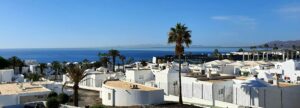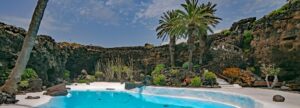The old capital of the island
The Real Villa de Teguise (royal city) was founded around 1406 by Maciot de Béthencourt, nephew of the Norman conqueror Jean de Béthencourt. Along with Betancuria on Fuerteventura, it is the oldest city in the Canary Islands. Maciot named the place after his partner Teguise. She was the daughter of Guardarfia, the previous ruler of the island and son of Queen Ico.
The inland location could not protect the city from recurring looting. A memorial plaque on Callejon de Sangre - the blood street - behind the parish church still reminds of these terrible events.
At the Plaza de la Constitución - the central square of the town - stands the church Nuestra Señora de Guadalupe with its three naves in neo-Gothic style. The church, originally built in 1428, was almost destroyed by several pirate attacks and a fire in 1909. Its landmark is the bell tower made of red volcanic rock.
Another attraction is the Vera Cruz Church, built in the 17th century.
Above the altar is the statue of Christ by Lujan Pérez, which is said to have washed ashore in a wooden box in the bay of Famara.
The Palacio Espinola, a museum with antique furniture and paintings, is located directly on the market square. Every Sunday there is a large flea market where you can find almost everything your heart desires: starting with jewelry, embroidery, clothes and African carvings to home-baked and dried fish.
The most famous Canarian musical instrument is the timple, a four-stringed instrument, similar to the guitar, which is said to have its origin in Teguise. There are still several timple builders in the city today. A workshop is located in the Escuela de Artesana school, right next to the Vera Cruz church.
The place is guarded by the Castillo Santa Barbara, an old Habsburg fortress. There a pirate museum offers an insight into the history of Lanzarote and from the nearby crater rim you have a wonderful view over the island.






